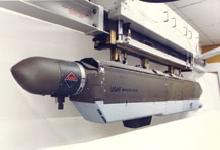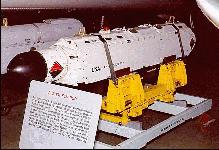




The AN/ALQ-131 Electronic Countermeasures Pod provides electronic countermeasures protection for USAF, ANG, AFRES, and FMS country aircraft. The AN/ALQ-131 is certified on the F-16, F-111, A-10, F-4, F-15, F-5 and C-130 aircraft. The ALQ-131 ECM Pod is modular in design containing various electronic receivers, antennas, and powerful transmitters designed to alter the flight path of an incoming enemy missile. This modular pod-mounted system can be configured to cope with a range of threats, spread over one to five frequency bands, by selecting individual modules for inclusion in the pod, the userthe pod to handle threats. Both noise and deception-jamming modes are available, and he pod can be reprogrammed to match the expected threat. The pod is controlled from the cockpit by both automatic and manual means. The cockpit control indicator is used to turn the system on, enable threat response actions, and display system status. ECM pods are pre-programmed on the ground for specific threats that may be encountered [ ...they also double as a pretty darn good microwave oven!].
The ALQ-131 pod contributes to full-dimensional protection by improving individual aircraft probability of survival. The ALQ-131 Block II is an upgraded version of a pod configured ECM system first fielded in the 1970s. The pod provides self protection jamming for USAF tactical fighter aircraft and is designed to operate in a dense, hostile environment of radar directed (RF) threats that require high duty cycle (pulse doppler) or CW jamming techniques. The ALQ-131 Block II is modularly constructed, providing a high degree of adaptability to various mission requirements. Basic hardware components include an Interface and control module, 2 or 3 Band modules that cover a portion of the pod's total frequency range, and the Receiver/Processor (R/P) module. The R/P module combines an accurate signal identification capability with power management. An important function of the R/P is the management of "look through" which permits periodic surveillance of the threat environment while jamming is in progress. This system is no longer in production for U.S. forces and is well past IOC. Operational Flight Program (OFP) Block software up-dates are expected about every two years, or as tactically required based on the continuum of threat evaluation to support theater tailored User Data Files (UDF), and jammer technique optimization.
DOT&E reported in FY92 that: (1) no evaluation of the AN/ALQ-131 Block II R/P system's operational effectiveness or operational suitability was possible, because the FEB88-JAN91 Qualification Operational Test & Evaluation (QOT&E) was not planned to support a B-LRIP decision, and that (2) FOT&E during FY93 was planned to eliminate the shortcomings of QOT&E. Subsequent budget and inventory decisions resulted in procurement not proceeding beyond low rate production. Specific DOT&E reservations concerning the adequacy of QOT&E concerned contractor involvement and changing software versions through the continuum of the QOT&E which was accelerated due to Desert Storm. FOT&E was conducted from APR92-OCT93 by USAF Air Warfare Center (AWC), final report October 1904, which reassessed effectiveness and suitability with (1) no contractor involvement and (2) a single software version. The FOT&E validated USAF QOT&E results that the AN/ALQ-131 Block II R/P system was overall effective and suitable. Additional testing has been conducted since 1993 to explore specific aspects of observed performance for the fielded system, versus specific threat systems or conditions, in support of sustainment upgrades, and optimization of operational employment tactics.
USAF(AWC) completed FY97 FOT&E of the Block Cycle I OFP update which implemented specific performance enhancements. The testing was completed at Eglin AFB in hardware in the loop facilities, and with flight tests. Five Critical Operational Issues (COIs) were evaluated:
These COIs depict the normal AWC assessment of software updates to render a fielding recommendation to HQ ACC. The Measures of Effectiveness (MOEs) and Measures of Performance (MOPs) are tailored to evaluate the unique changes in each software update. Typical MOPS for jamming effectiveness include correct response, reduction in lethality, reduction in shots, reduction in hits, reduction in tracking, miss distance, and threat detection range.
Four operational change requests that were not operationally critical but warranted more than routine handling were submitted in June 1997 and will be released before the Block Cycle II update which is planned for FY99. Initial testing of this interim update was accomplished in July through August 1997. An additional change is being incorporated and the update (Link 41) will be re-tested and fielded in FY98.
DOT&E staff have monitored the activity and T&E process through review of the FOT&E Test Plans, dialogue and visits, and review of reported results. The TEMP has not been updated since the Block II R/P IOC and sustainment FOT&E Test Plans are not submitted for DOT&E approval.
The FY97 FOT&E of the Block Cycle I OFP software update tested the implementation of specific performance enhancements. The AWC T&E process uses a sound mix of hardware-in-the-loop testing and flight testing. The Block Cycle I OFP updates were assessed to provide the desired operational improvements while not impacting operational effectiveness, compatibility, interoperability, suitability, or tactics. No deficiency reports were filed. The test team recommended fielding as addressed in USAF, 53rd Wing message 241319ZDEC96, ALQ-131 Block Cycle 001 End of Test Message, Secret.
| Air Force ACAT II Program No longer in production Prime Contractor Westinghouse Electronics ALQ-131 BLK II Pod total system integration. LORAL Defense Electronics Receiver Processor (R/P) module and integration. | ||

